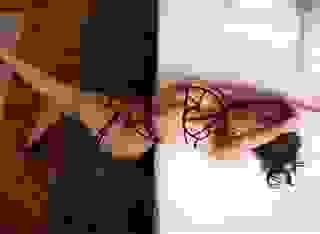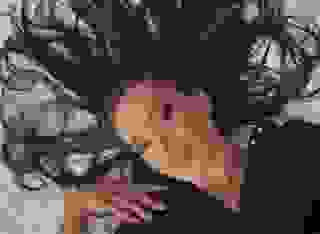- Non-Erotic
- The Man Eating Lions of Tsavo
Note: You can change font size, font face, and turn on dark mode by clicking the "A" icon tab in the Story Info Box.
You can temporarily switch back to a Classic Literotica® experience during our ongoing public Beta testing. Please consider leaving feedback on issues you experience or suggest improvements.
Click hereThey are the two most famous man-eating lions in history. Hollywood made a movie about them and there have been numerous books written about them, but lions normally don’t consider humans a food source.
The name Tsavo means “place of slaughter,” and it’s a semi-arid region, a tough place to scratch out a living for either man or beast. And although today it’s a National Park in Kenya, it hasn’t changed that much since the days of the man-eating lions.
In the early part of the 20th century, the Tsavo was know for the rhinos and elephants with heavy ivory, and the reason for the heavy ivory was the thick thorn brush which kept out hunters and let the rhinos and elephants live longer. The Tsavo was also known for the lions which looked at humans as just another source of protein, but to understand why the lions of Tsavo were so aggressive it is necessary to go back in time.
For hundreds of years before the West was even aware of the Tsavo, native tribes lived in the area, and from time to time, wars would break out among them. And after a battle, it was the custom of the time to leave the dead and dying where they fell, and the smell of the dead and the moans and blood of the dying would attract lions and hyenas, but mostly lions, to the feast on human flesh. Now, the lion may be the king of beasts but is not a picky eater and will eat whatever doesn’t eat him first. This gave the lions a taste for human flesh, and the Tsavo being a semi-arid region with very few of the savanna animals lions normally feed on, humans became a primary food source.
Then in the late 1700s and the early 1800s slave traders made raids into the interior of Africa, and in order to get back to Mombassa, the main slave port, they had to go through the Tsavo. And when the slave traders reached the Tsavo, they knew it was another 150 miles to Mombassa, and they made a habit of stopping at the Tsavo River to rest up and sort through their human cargo before the last leg of their journey. At this point slaves who were too weak or lame to make the trip to Mombassa were left behind to fend for themselves, and in a day or two after the slave traders had left, the lions and hyenas would move in and eat the abandoned slaves. A few decades of slaves being abandoned in the Tsavo, and you have the perfect set up for trouble with the lions of the Tsavo.
Eventually the slave trade dried up, and in the late 1800s, the British came to East Africa and put a stop to the tribal wars in the Tsavo and set up a trading post called Nairobi. In time Nairobi grew so large that the British decided to encourage growth in the interior of Kenya and to do so started building a railroad that would run from Mombassa to Nairobi and on to Uganda. The British started building the railroad at Mombassa, but before they had gotten very far, building the railroad turned into a race between them and the Germans to get to Uganda first. And the competition became so fierce that the British newspaper started calling the railroad the “lunatic line.”
And this was situation when, in 1898, Lt. Colonel J.N. Patterson arrived in the Tsavo The Mombassa to Uganda railroad had reached the Tsavo River, and he was there to build a bridge across the river. Or at least that’s what Colonel Patterson thought he’d signed up for, but it turned out building the bridge was the least of his troubles.
The first problem Colonel Patterson had to deal with was the thousands of Indian workers who had been shipped in to work on the railroad and the native workers from the area who had been hired to work on the railroad. The workers were in camps scattered up and down both sides of the railroad line, but given that the Indians followed the caste system and the smorgasbord of belief systems and religions among the Indians and natives there was a lot of friction between the camps and in the camps. Plus, conditions in the camps were primitive, as were the working conditions, and this led to a lot of disease and accidents and deaths. And if that wasn’t enough, some of the Indians were vegetarians and refused to work with people who weren’t, other Indians refused to work with someone who wasn’t of their caste, and other workers refused to work with those who didn’t follow their religion.
Colonel Patterson had worked in India and managed to settle the problems with his workers, but then another problem popped up. They were behind schedule, and the higher ups in Nairobi and England were breathing down his neck to get the bridge built. On the other side of the Tsavo River they were laying two miles of track a day, and the bridge was needed to keep those workers supplied with food and material. All Colonel Patterson could do was push his men, but then about two weeks after he arrived in the Tsavo, the first worker disappeared in the middle of the night.
The worker had been carried off by a lion, and two days later another worker disappeared from a camp, followed shortly by another and another. And soon the workers wanted to leave because they thought there had been no problems with lions until Colonel Patterson had arrived. He tried to solve the problem by sitting up nights waiting where he thought the lions would strike next, but the lions seemed to know were he was and would hit somewhere else down the railroad line. Frustrated, he sent word down the line that he needed some help and asked for a squad of soldiers. The problem was taken up by Parliament, but Parliament decided that the British nation would look weak to the rest of the world if they had to sent a squad of soldiers to deal with some pesky lions.
Basically, the powers that be told Colonel Patterson to deal with the problem and be quick about it, but that wasn’t much help to him because his workers were on the verge of laying down their tools and walking away. olting. Then he caught a break and killed one of the man-eating lions, and a few days later he caught a second lion in a cage trap he had built. Both lions were healthy, and after they were skinned and salted, an examination of their carcasses revealed no reason why they should have turned into man-eaters.
After the death of the two lions, the bridge was built and life went on in the Tsavo, but the bridge had cost the lives of 28 Indian works and an unknown number of African natives. There is no way to know how many African natives were killed in the area because no records were kept of them so officially the two Tsavo lions were only credited with 28 kills.
Colonel Patterson was not a professional hunter and he had several close calls while hunting the lions. Several times when backtracking himself out of the brush he came across lion tracks on the boot prints he’d made just a few minutes before. As he said in one of his reports, “If it hadn’t been for the Grace of God, I might have been one of the lions’ victims.”
But what makes this story so interesting is the question, what turned the two lions into man-eaters? Were they man-eaters because they came from a group of lions who had eaten humans on a semi-regular basis for years? Were they man-eaters because they were freaks of nature? Or were they man-eaters, as some of the African natives thought, because two long-dead witch doctors had conjured them up to drive off the white invaders? Or were the lions man-eaters, as some of the Indian workers believed, because Colonel Patterson had bad karma and the killings hadn’t started until he showed up?
But instead of all this conjecture, let’s look at some facts. The Tsavo is a semi-arid region where temperatures often reach 115 degrees or more in the summer. The ground is hard as concrete and rocky, and it’s easy to break a limb if you fall on it the wrong way. Plus, working on the railroad was hard and dangerous work, and if an accident at work didn’t kill you, there were other ways to die. There was disease, bad food, poisonous snakes, accidents, and fights that could turn deadly. Yes, the workers had a doctor and a crude hospital of sorts but this was 1898, and by our standards the best care in a hospital in London was poor so it’s easy to imagine what the medical care was like in the Tsavo back then. Then add in the medicine we take for granted today, and a simple scratch could get infected and kill a worker in a few days. And the high mortality rate, three a day and sometimes more, meant there were bodies to dispose of, which presented a problem. The Indian workers wouldn’t touch a dead body because only the lowest caste, the untouchables, were supposed to do this. So Colonel Patterson solved the problem by putting together burial parties which consisted of untouchables, and besides their weekly pay, each of the untouchables was paid two shillings for each body they buried. Now this is where it gets interesting. Years later, professional hunters in Kenya talked to Indian families whose fathers and grandfathers had worked on the railroad line in the Tsavo, and they were told the burial workers back then had often taken a body only a mile or so from the tracks before they would scratch out a shallow grave, put the body in it, and cover the grave with just a few rocks and some thorn branches. Then they would go back to camp, get the next body, and repeat the process. And you can’t really blame the burial party for doing things the way they did. The more bodies they buried the more they got paid, and also, it was hot, the ground hard, and when lions are around, you don’t want to spend much time out in the bush. So this means the bodies were carelessly buried, and although Colonel Patterson probably didn’t know the bodies were being buried this way, you can see where the practice would attract lions. A hungry lion will eat anything, especially rotting human flesh easy to get it, and over the years a lot of professional hunters in Kenya have suggested in their books that the Tsavo workers have only themselves to blame for the two man-eating lions. Once the lions got into the habit of eating dead workers and found out they liked the taste of human flesh it only stands to reason that they would started sneaking into the camps to get fresher meat.
But who am I to tell you what to believe? I just gave you the facts and you can draw your own conclusions. All the principle player are dead, a brief footnote in the mists of time and history. Time marches on, and there have been other lions in Africa which have ran up higher scores in human lives, but none have been as famous as the two man-eaters of the Tsavo.
As I said earlier, today, the Tsavo is a National Park in Kenya, and it’s still hot and dry in summer. The rhinos are gone but the elephants and the lions are still there. You can fly into Mombassa and take the train west to the Tsavo or drive there if you want to. You can still see the bridge that Patterson built over the Tsavo River and also the railway station he built near where he was camped on the river’s bank. Even today a chill will run up your spine if you close your eyes and let your mind drift back in time to over 105 years ago. If you stay the night at the lodge next to the Tsavo River, I wouldn’t wander too far out of the lights or you might find yourself face-to-face with one of the lions descended from the man-eaters of Tsavo. Chances are the lion will be as startled as you are and will run away, but then again he might decide to carry on a family tradition and see what human flesh tastes like. But you don’t have to go all the way to Africa to see the Tsavo man-eaters. Just go to Chicago, visit the Natural History Museum, and behind a glass case you will see the faces of the man-eaters which were harbingers of death in 1898 in a lonely place called the Tsavo.
As I have said you are free to believe whatever you want about the Tsavo man-eaters. Maybe one day we’ll meet and you can tell me your theory, but you can bet if we meet at the Tsavo River and the sun is setting I will be in the lodge at the bar having a drink and not wandering around outside. And when I hear a lion grunting off in the distance I’ll wonder if I’m hearing one of the descendents of the Tsavo man-eaters. And if I’m really in the mood, I’ll be wondering if the lion likes the taste of human flesh and is thinking about outdoing his great-great-great grandfather. Perhaps he is because one never knows about Tsavo, a name which means “place of slaughter.”
- COMMENTS
I hope the writer does not expect to be taken seriously. His facts are quite wrong.
get extra pay, blaming the death to the liones!
Only joking.
Geez. I miss the Discovery channel. I shouldn't, but I do. TV addiction, I worry, maybe the one of the greatest danger unspoken of. How many of our next generation is addicted to broadband internet, acumurating information, yet too lazy to act?
Oh, shit! There goes my next idea for my writing onto the public domain!








